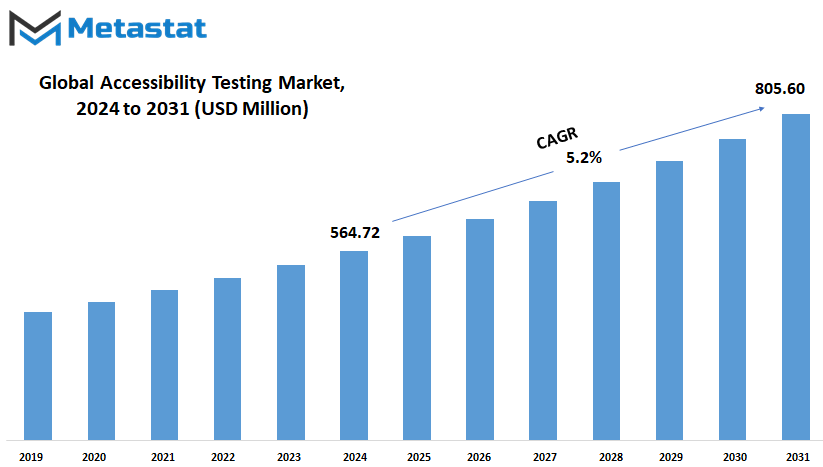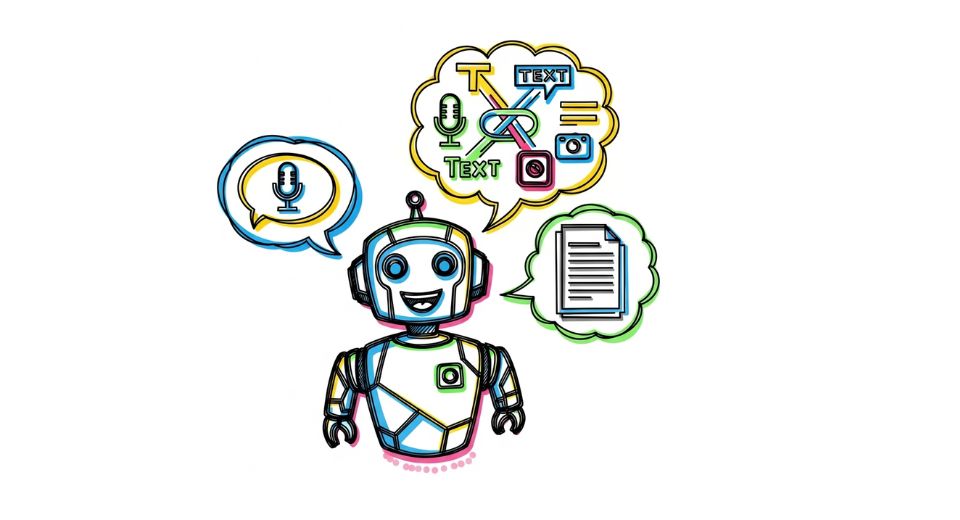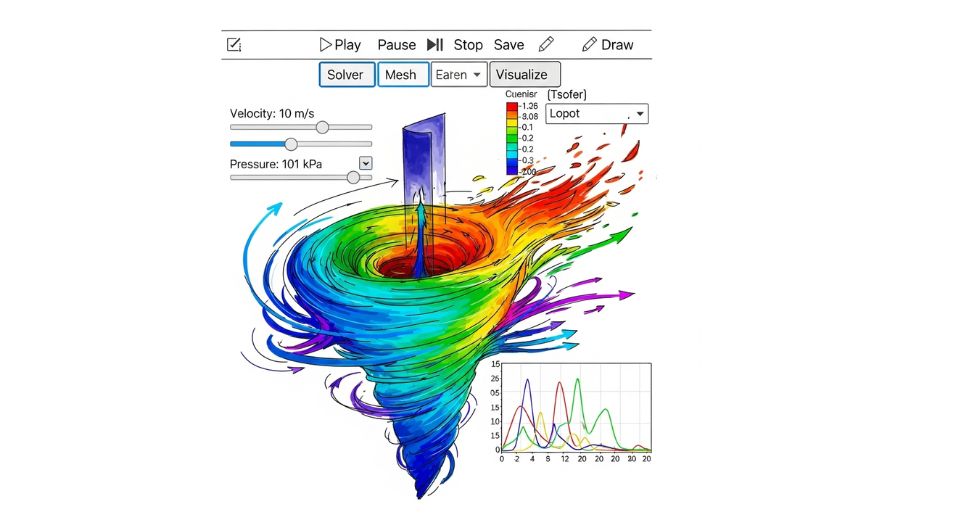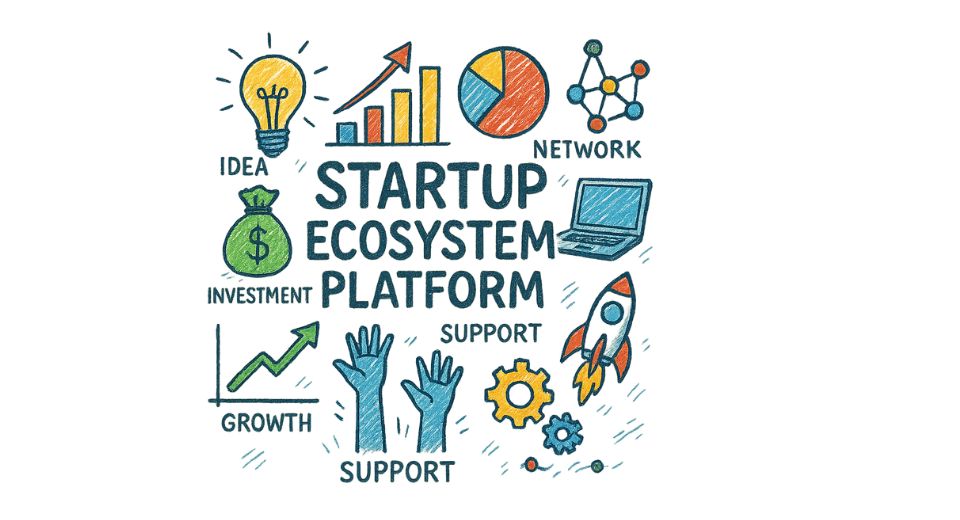MARKET OVERVIEW
The Global accessibility testing market is thus a niche, specialized segment under the software and technology industry specializing in ensuring there is access through digital products and platforms and all services to disability. The marketplace is driven and fueled by needs; it is creating an inclusive setting for digital in line with acceptable standards and fulfilling legal requirements to be met. It includes website and application reviews and improvement processes to make sure that the interface is accessible for people with diverse abilities.
Accessibility testing looks for and eliminates any barriers which could prevent effective user interaction with digital systems. These include considerations like compatibility with screen readers, ease of keyboard navigation, and accessibility guidelines such as Web Content Accessibility Guidelines (WCAG). The requirements are driven by the need to open up users’ access, coupled with corporate social responsibility toward society.
The Global Accessibility Testing market will find greater importance, as digital transformations speed up everywhere in the sector. Governments as well as relevant regulatory bodies from around the globe are focusing greatly on enforcing the accessibility compliance at the right places, that compels industries to give importance for the same reason. Moreover, the global old age population demands will increase through digital platforms while dealing with customers with age-based impairments also.
Testing methods and tools in this market are continually changing with new technology. The integration of artificial intelligence and machine learning will make it possible to improve the testing capabilities by faster and more accurate detection of accessibility issues. In addition, automation tools are being developed to reduce the time and effort spent in testing without sacrificing precision.
Beyond mere regulatory compliance, Global Accessibility Testing extends to providing an excellent user experience for all. Customer satisfaction and loyalty are significantly promoted through accessibility testing. For sectors like e-commerce, healthcare, education, and entertainment, services are now largely delivered digitally, and thus there is a growing interest in accessibility testing. Beyond ethical obligation, inclusivity serves as a positive influence on brand reputation and market competitiveness.
This market is further influenced by collaborative efforts from developers, designers, and testers as they work towards creating accessible digital ecosystems. This expertise is valuable in identifying and resolving accessibility challenges at the early stages of the development cycle, avoiding costly redesigns or legal disputes. Service providers in this industry offer manual testing, automated tools, and consulting services designed to meet unique client needs.
In the near future, it will be quite promising as business organizations understand accessibility to be an essential part of their digital strategy. The innovations are going to come at the same time as emerging technologies such as augmented reality and virtual reality would need new ways to approach accessibility testing, thereby widening the scope of this market. This focus on inclusivity will ensure that digital progress benefits all members of society, highlighting the critical role of accessibility testing in shaping a more equitable digital future.
Global Accessibility Testing market is estimated to reach $805.60 Million by 2031; growing at a CAGR of 5.2% from 2024 to 2031.

GROWTH FACTORS
The Global Accessibility Testing market is going to witness steady growth in the coming years. Several factors will drive the expansion of the Global Accessibility Testing market. Accessibility testing is necessary to ensure that all websites, mobile applications, and digital platforms are usable by all individuals, including those with disabilities. With growing business focus on improving user experience, demand for accessibility testing services is going to increase.
Among the most significant growth factors for the Global Accessibility Testing market is rising awareness about inclusivity. As governments across the world impose stricter regulations on digital accessibility, organizations are left with no other option but to abide by them. This has driven many companies to implement accessibility testing tools and services so that their digital content complies with legal and ethical standards. The more people with disabilities are increasingly using digital platforms, the greater is the demand for accessible websites and applications. This rising user base is likely to fuel further demands for even more robust solutions in accessibility testing.
Also, advancements in technology are driving growth in the Global Accessibility Testing market. Automated testing tools have emerged to identify issues related to accessibility easily and efficiently. These automated tools are significantly beneficial for websites and applications, which are enormous in size because testing them through human effort will take a very long time and prove costly. Thus, more automated technology will surely further enhance accessibility testing.
However, some obstacles may deter market growth. One of these is the high cost associated with accessibility testing. For smaller businesses or startups, the financial burden of adopting such testing procedures may seem overwhelming, slowing down adoption rates. Another challenge to market growth is the limited pool of professionals specializing in accessibility testing. As the demand for such services grows, there will be a requirement for more trained experts to meet this demand.
On the other hand, the growing integration of AI and ML in accessibility testing tools will offer the market lucrative opportunities. Advanced technologies can improve the accuracy and efficiency of accessibility testing, offering more precise insights into potential issues. As AI and ML continue to evolve, the future of the Global Accessibility Testing market is also expected to shape up in order to make businesses of all sizes more effective and accessible.
MARKET SEGMENTATION
By Type
The Global Accessibility Testing market is an essential part of making sure that all users, including people with disabilities, have access to digital platforms. The more that businesses expand digitally across industries, the more they will focus on accessibility. This market will grow considerably over the next several years as more companies understand the importance of being inclusive and having to comply. The growth of awareness on the issues of accessibility, legal compulsions, and the rising demands for accessible digital experiences drive this market. As businesses are waking up to realize that it’s not only the law but a strategic play where making websites and applications accessible could enhance brand reputation and customer loyalty.
In terms of market segmentation, the Global Accessibility Testing market is segmented into several categories, with one being based on type. The testing methods in this segment include Manual Accessibility Testing, Automated Accessibility Testing, and Hybrid Testing. These categories represent the various ways accessibility testing is approached, with each method offering its benefits. Manual Accessibility Testing is valued at USD 232.28 million in 2024. It involves human testers to test the accessibility of websites and applications. It gives a more profound, subtle understanding of how a product performs from a user's perspective, especially for those with specific needs or disabilities. This method remains critical as it helps uncover issues that automated systems may miss.
Automated Accessibility Testing, valued at USD 204.96 million in 2024, is a faster and more efficient way to identify accessibility problems. It uses software tools to check compliance with accessibility standards, such as WCAG (Web Content Accessibility Guidelines). This approach is valuable for quickly identifying common issues and ensuring that the product meets the baseline accessibility requirements. Automated testing may not always be able to replicate the user experience, so even though it is faster than manual testing, there is still a need for manual testing.
Hybrid Testing, in 2024, is expected to be priced at USD 127.49 million. A combination of benefits from both methods of testing—manual and automation—Hybrid Testing is increasing in popularity where companies can achieve the speed efficiency of automated tools while still realizing the human input that manual testing provides. A more comprehensive appraisal and a fair approach to diagnosing and curing accessibility issues could be ensured in Hybrid Testing.
In the future, the need for Global Accessibility Testing services will continue to rise as more businesses start to focus on inclusive design and try to achieve legal compliance. As technology evolves, these testing methods will also get more sophisticated and make it easier for businesses to provide accessible experiences for all users. The expansion of the Global Accessibility Testing market is not just a legal mandate but also a way of creating a digital world where every individual, with or without their abilities, can fully engage and participate.
By Application
Global Accessibility Testing market is showing rapid growth during the past years, mainly as a reflection of the rising demand for products and services which offer inclusivity to all types of users. Since technology has continued to evolve over time, business organizations across the globe are placing emphasis on how digital platforms should be made accessible to persons with disabilities. It’s not only for compliance but more so as businesses realize the fact that accessibility allows them to access a massive untapped potential audience.
The market would only continue growing as accessibility becomes of increased importance and becomes more possible to achieve with varying platforms in the future. Segmented based on application, the Global Accessibility Testing market is distributed across web applications, mobile applications, and desktop applications. It gives rise to different challenges as well as different prospects that could create a diverse scope for years ahead in digital accessibility.
Web applications are expected to dominate the market as the primary mode of interaction for users worldwide. The rise of e-commerce, online services, and cloud-based platforms means that ensuring web accessibility will be a priority for businesses. As more companies recognize the importance of inclusive design, web accessibility testing tools and solutions will become more sophisticated. Future developments are likely to encompass automated testing capabilities that can identify accessibility barriers rapidly across a vast number of websites, enabling businesses to address these issues before they impact users.
Mobile applications, with their ever-growing role in life, will also see significant developments in accessibility testing. With the services that include communication, shopping, and banking now incorporated in mobiles, business necessities offer accessible experiences to all the users. In the future, mobile app accessibility testing will most probably involve the use of advanced AI and machine learning technologies to automatically detect the issues of accessibility and give the developers the real-time feedback to act on those issues. This will now make it smooth for businesses as they will, therefore, pass the accessibility bar with ease by offering a totally seamless user experience.
Desktop Applications
Desktop application will also turn out to remain one of the key segment areas in Global Accessibility Testing, though mobile and web-based applications are indeed on the growing trend. Software applications on personal computers are often used in quite a number of professional environments while the workforce at work is becoming both diverse and diverse. The future of accessibility testing for desktop applications will be about compatibility with various assistive technologies, such as screen readers and voice recognition software, and making the overall usability of the software better for users with disabilities.
The prospects for Global Accessibility Testing are bright. As business and governments, and even organizations, will continue to place accessibility at the top of the list, innovations in the testing tool and method continuously create an easier time in ensuring that digital products are usable by everyone despite their disabilities, creating a more inclusive and accessible digital world, to both the user and business.
By Organization Size
There’s a rapid rise in the global accessibility testing market because more businesses are now interested in making their products and services accessible to one and all despite their abilities or disabilities. Nowadays, as there’s technology advancement, this has created greater demand for accessing websites, apps, and others through digital space testing for its accessibility. This is not only an issue of being in compliance with the legal statutes but also opens opportunities for companies to reach an expanded market segment so that people with disabilities may access them just as easily. Demand for accessibility testing services would, therefore, become more pronounced with time as organizations look to making experiences accessible for users of varying needs.
In the future, we will certainly witness more and more organizations using accessibility testing as a part of their development processes. The market would witness a broad shift towards the automation of accessibility testing, because of the advanced artificial intelligence and machine learning technologies. It will assist businesses in executing more comprehensive assessments of their digital products at a quicker rate, providing them with the opportunity to recognize potential accessibility barriers early in the development process, thus saving the cost and time incurred by laborious manual testing and enabling them to deliver accessible solutions faster.
The Global Accessibility Testing market can be segmented into two significant categories: Small and Medium Enterprises (SMEs) and Large Enterprises, which differ by organization size. For Small and medium-sized businesses, which typically have fewer resources, understanding the importance of accessibility testing will only grow as companies realize the need for better brand reputation and greater exposure in the market. Demand for cost-effective and user-friendly testing tools and services will increase as SMEs adopt accessibility testing practices. They will realize a fit-for-purpose set of solutions that are made with their particular needs in mind, ensuring accessibility is integrated into their services but not overwhelming their resource constraints.
As such, large enterprises will still lead the Global Accessibility Testing market because of their bigger budgets and more complex digital ecosystems. These organizations, with their vast customer bases, will place a higher priority on accessibility to ensure their platforms meet the needs of diverse audiences across the globe. Large enterprises will drive the demand for more comprehensive and scalable testing solutions, often integrating accessibility testing into their ongoing development workflows. This would involve advanced analytics and automated testing systems, which can handle a large number of devices and platforms, ensuring that accessibility standards are met.
As the Global Accessibility Testing market continues to grow, it will continue to be a vital component in how businesses should approach the design and development of digital products and services in order that they ensure that digital products or services provided to customers should be inclusive and accessible to everybody.
By Industry Vertical
The Global Accessibility Testing market has become a significant part of several industries, which are working towards providing more accessible services and products to a larger audience. Accessibility testing ensures that digital platforms, websites, and applications are accessible to everyone, including people with disabilities. With the growing expansion of the digital world, the demand for services catering to all users regardless of their abilities is increasing. This shift is going to shape the future of industries across different sectors, pushing them to prioritize accessibility testing in their development processes.
The IT & Telecom sector is one of the largest contributors to the Global Accessibility Testing market. The rapid progress in technology and the increased reliance on digital platforms have made it necessary for companies within this industry to ensure that services are accessible to all users. In the future, IT & Telecom will be built around developing platforms that are intuitive and easy to navigate, irrespective of a user’s physical or cognitive abilities. Accessibility testing will facilitate identification of scopes to enhance the existing features so that digital products and services can meet a more heterogeneous customer base.
In the Banking, Financial Services, and Insurance (BFSI) space, accessibility has emerged as one of the biggest requirements as all financial services now migrate to digital. The market for Global Accessibility Testing is likely to increase in this direction as many banks and other financial institutions have begun to make their platforms accessible. This is essential for consumers with disabilities relying on such operations to conduct all their daily functions. The increased occurrence of digital banking means that in the future, finance companies will face a responsibility for regular accessibility checks on their Web applications to keep them user friendly.
Healthcare is another sector where the role of accessibility testing will be significant. As more healthcare services shift to online platforms, including telemedicine and patient portals, the importance of accessibility will only grow. Ensuring that these platforms are accessible to people with various disabilities will be essential to improve overall healthcare outcomes. The future of healthcare will likely involve more inclusive platforms, making accessibility testing a necessary tool in their development.
The Global Accessibility Testing market will, in turn benefit retail and e-commerce platforms because, as a higher percentage of people shop online, it becomes paramount for companies to ensure that websites and applications have accessibility. For the fact that a considerable part of the customers may be those with disabilities, it is only important that their website should not offer a barrier on navigation through any e-commerce websites. We should have more retailers who adopt accessibility best practices as part of their standard processes in development in the coming years.
Access to education and online educational portals is the next. Education needs an easy means through which disabled students should access them on e-learning. An increased level of e-learning raises the importance for accessibility. All education-related systems, and education and learning technologies will most certainly have an opportunity in testing it to increase reach among more divergent populations; this means inclusion in the acquisition of knowledge between individuals, even in schools or e-learning networks.
The future is expected to find the Global Accessibility Testing market broadening into many other industries once more sectors grasp the importance of accessibility. Technologies will continue developing, and consequently, the necessity for accessible digital experience will grow day by day. Hence, investing in accessibility testing enables businesses in such various industries cater to a diverse audience, creating their digital platforms that are usable to all.
|
Forecast Period |
2024-2031 |
|
Market Size in 2024 |
$564.72 million |
|
Market Size by 2031 |
$805.60 Million |
|
Growth Rate from 2024 to 2031 |
5.2% |
|
Base Year |
2022 |
|
Regions Covered |
North America, Europe, Asia-Pacific Green, South America, Middle East & Africa |
REGIONAL ANALYSIS
The global market for Accessibility Testing is witnessing rapid growth as it focuses on creating an accessible digital environment for users with disabilities. This market is expected to continue its growth as more businesses, organizations, and governments focus on enhancing the experience of the digital world for everyone. Changing regulations and increasing awareness regarding the importance of accessibility are also shaping the market's expansion. Accessibility testing is expected to grow further with each region in the future to exhibit unique trends and challenges owing to their distinctive social, economic, and technological contexts.
The North American Accessibility Testing market will remain one of the strongest ones globally. Countries such as the U.S. and Canada are pioneers in leading accessibility initiatives. With more companies implementing accessibility laws and regulations, such as the Americans with Disabilities Act (ADA), the region will continue to be at the forefront of digital accessibility. In addition, the U.S. has many global tech companies that focus on inclusive design, which ensures that accessibility is integrated into new digital platforms and applications. In the next coming years, only growing awareness by businesses for access to digital content will grow.
Europe is an important region of Accessibility Testing and is represented in this market. UK, Germany, and France are among these countries, who are ahead of other nations and pushing forward to digital accessibility. Europe will relate access testing with European directives on access requirements that obligate the accessibility standards for all websites related to public sector agencies. Since age demographics of this continent are old and their increasing requirement for highly accessible digital interactions will continue in Europe, access testing service sophistication is going to soar up over here. Moreover, accessibility best practices are expected to be adopted by businesses in Europe, which would raise the demand for specialized testing tools and services.
The Asia-Pacific region is rapidly catching up in terms of accessibility awareness. Countries like India, China, Japan, and South Korea are taking steps to ensure that their growing digital infrastructure is accessible to all users. More and more businesses in the region are expanding their digital presence, which is making accessibility testing a priority to ensure that websites and applications are accessible to users with disabilities. As the region's digital economy continues to grow, so will the market for accessibility testing services, especially in countries like India and China, where large populations and digital adoption present significant opportunities.
South America gradually understands the concept of digital accessibility through Brazil and Argentina. It is still not matured for the standards but shows growing interest and demand from people in South America. It is expected to grow in demand for the region of Middle East and Africa in the future as well. In a few years, accessibility testing will become a critical aspect of ensuring that the technologies are usable by all, especially with the continued adoption of technology in countries like South Africa and Egypt.

COMPETITIVE PLAYERS
The Global Accessibility Testing market is fast increasing because businesses and organizations everywhere increasingly recognize the need for accessible digital experience. The demand is therefore created by an awareness of the requirements to include persons with disabilities in the online world. This can be very promising, since advancement in technology demands accessibility testing. Websites, applications, and services should, after all, be made accessible for anyone, whatever one's disabilities or capabilities might be. A growing future requirement for accessible digital experience will have importance for companies creating this market.
Many are the important participants in the market of Accessibility Testing that help design a future market. QualiTest, Invensis, and Deque Systems top the list when it comes to companies providing solutions that ensure businesses can point out and subsequently correct accessibility faults in their digital products. A comprehensive testing solution has been crafted by these organizations to ensure one's product not only meets WCAG, ADA, and Section 508 compliance but also guarantees that all web content adheres to these parameters.
As the requirement for inclusive design is increasing by the day, companies like Equal Entry, TPGi, or The Paciello Group and Applause place themselves as front-runners who offer accessibility solutions. These firms work closely with their clients, incorporating accessibility considerations into the developmental process to satisfy the needs of visually, auditory, cognitively, or motor-impaired individuals. Their services range from manual testing to automated solutions, providing a comprehensive package for businesses that wish to enhance the accessibility of their digital platforms.
Alongside these established players, new entrants like Planit, Siteimprove, and Ten10 are also contributing to the market’s expansion. These companies bring fresh approaches to accessibility testing, often utilizing the latest tools and technologies to improve the speed and accuracy of testing processes. They aim to make it easier for organizations to spot issues early in the development cycle, allowing them to address accessibility concerns before products are launched.
As the world moves forward with increased focus on inclusion, companies such as UsableNet, AudioEye, Happiest Minds, and TestingXperts are further elevating the industry with innovative solutions. These players are increasingly leveraging AI-powered tools and machine learning techniques to enable organizations to test accessibility at scale. Their solutions are designed to not only detect accessibility issues but also provide actionable insights on how to improve the user experience for all.
With so many significant players, it is expected to be promising at the future for the Global Accessibility Testing market. As technology will advance and the businesses become more committed to inclusions, it will become highly important for the accessibility testing services. Competitive players in this market are all poised to make it happen, allowing the digital world to become an accessible space regardless of ability.
Accessibility Testing Market Key Segments:
By Type
- Manual Accessibility Testing
- Automated Accessibility Testing
- Hybrid Testing
By Application
- Web Applications
- Mobile Applications
- Desktop Applications
By Organization Size
- Small and Medium Enterprises (SMEs)
- Large Enterprises
By Industry Vertical
- IT & Telecom
- Banking, Financial Services, and Insurance (BFSI)
- Healthcare
- Retail and E-commerce
- Education
- Other
Key Global Accessibility Testing Industry Players
- QualiTest
- Invensis
- Deque Systems
- Equal Entry
- TPGi (The Paciello Group)
- Applause
- Planit
- Siteimprove
- Ten10
- UsableNet
- AudioEye
- Happiest Minds
- TestingXperts
- Zoonou
- Knowbility
WHAT REPORT PROVIDES
- Full in-depth analysis of the parent Industry
- Important changes in market and its dynamics
- Segmentation details of the market
- Former, on-going, and projected market analysis in terms of volume and value
- Assessment of niche industry developments
- Market share analysis
- Key strategies of major players
- Emerging segments and regional growth potential








 US: +1 3023308252
US: +1 3023308252






